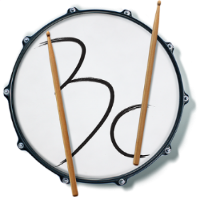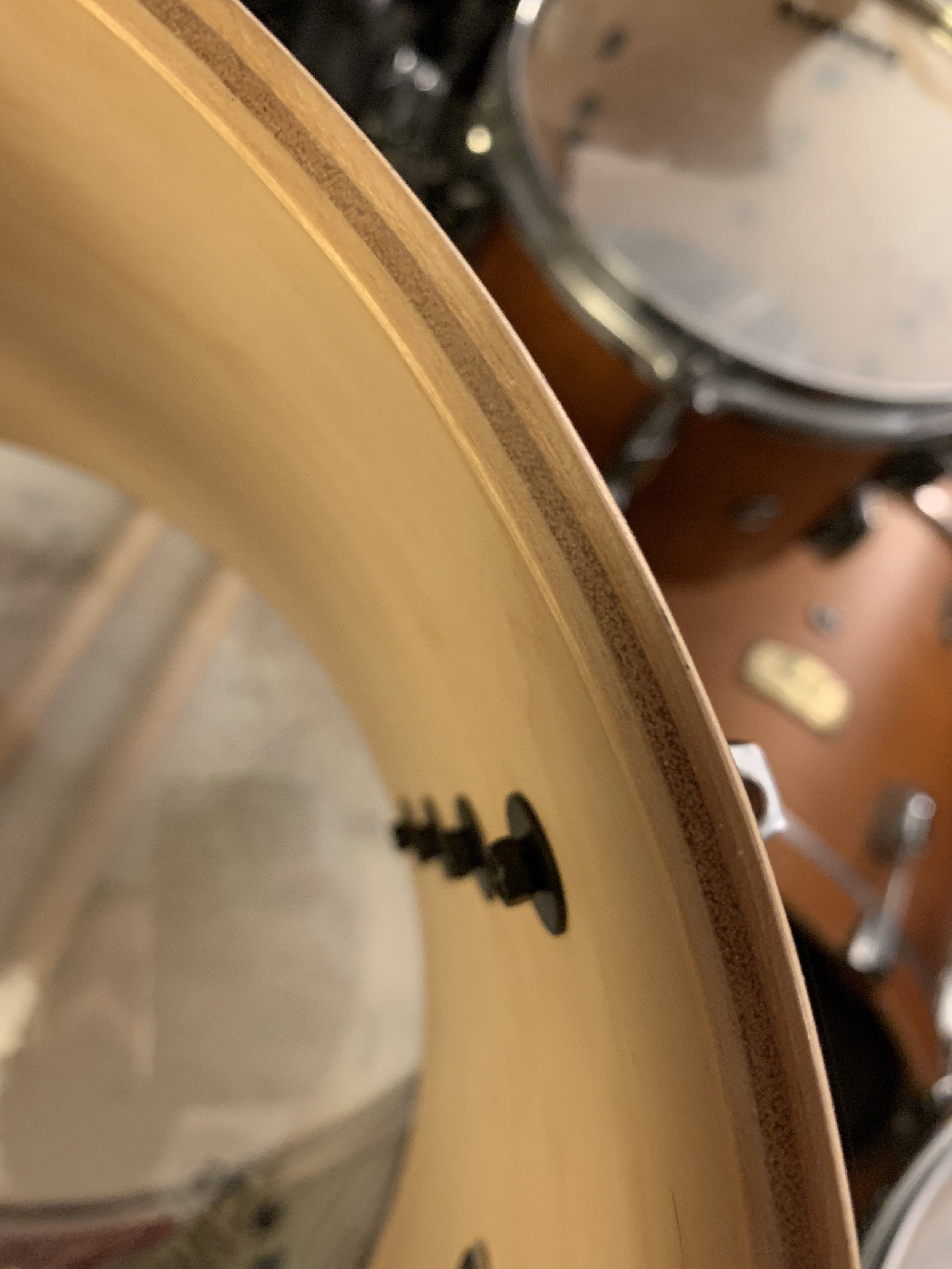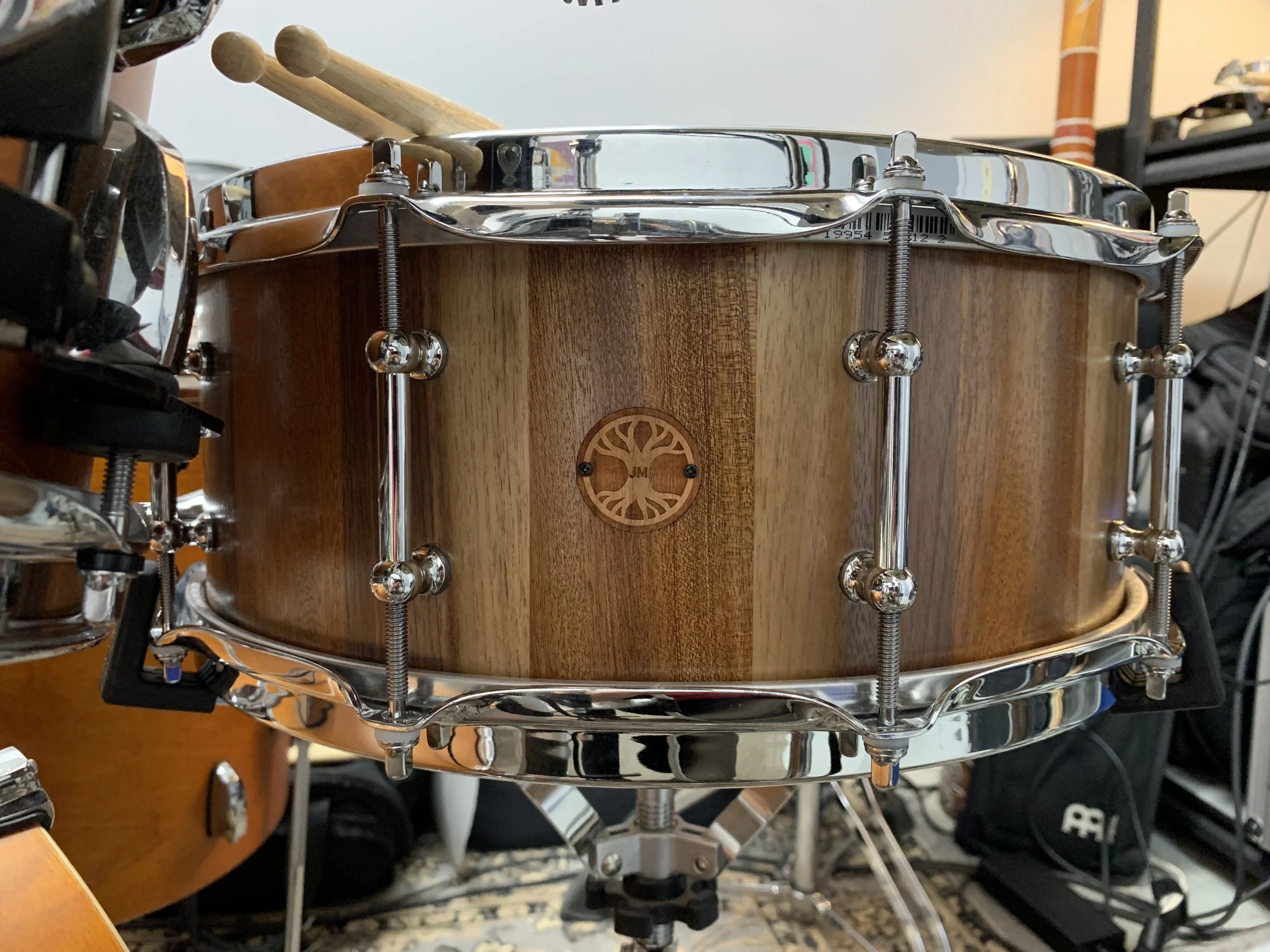Shell Shocked: Methods of Wood Drum Construction
The art of drum building has been developed and refined over the course of hundreds of years. Many elements of a drum shell’s construction will have a direct impact on how the drum sounds and responds. While the majority of drums are built from wood, one of the biggest factors that impacts a drum’s sound is how the wood is used. Aside from the diameter, depth, and material of the drums, the method of construction affects everything from the tone and look to the price. Let’s take a look at all the common ways to build a drum using wood.
Plies
Ply
Building drums using plies is the most common method of drum shell construction. Plies are thin sheets of wood, which are bent into a cylinder and glued together with other plies. Most drums are built with somewhere between 5 and 9 plies, though there could be as few as 3 plies (common among some vintage drums), or as many as 40 plies. The thicker the shell, the higher the fundamental pitch of the drum will be, but at the cost of resonance. Thinner shells will produce a lower fundamental pitch that sounds for longer. Ply drums are much more easily mass manufactured compared to other methods since builders can use molds and standardized measurements to quickly assemble shells. As a result, they require less labor and are often a bit cheaper than other types of drums. If you own a drum set, chances are the drums are made with plies. You can see each ply in the shell pictured right.
Stave
A popular method among DIY builders and smaller workshops, stave construction entails cutting pieces of wood into trapezoids. Cuts are made in the same direction as the wood grain. With all of the pieces laying next to each other, they’re each glued on the long inner sides and wrapped end-to-end, forming a cylinder (similar to a barrel’s construction). Stave shells use much less glue compared to ply shells, allowing the wood’s natural tone to more easily come through. Stave shells also don’t really run the risk of bending out of round since there’s no stress placed upon the wood to keep it in shape. Poorly constructed ply drums may begin to separate over time if not handled carefully since the wood will always want to return to its natural straighter state. Stave drums typically have shorter sustain and a more focused, articulate sound compared to ply drums. It’s also common to mix two or more different wood types together with this method of shell construction. Due to the amount of cuts that need to be made, stave drums require more labor to complete compared to ply shells and are typically more expensive. The snare drum pictured below (built by Philly Drum Co.) is constructed from a combination of walnut and mahogany pieces.
Stave
Segmented
Segmented
Similar to how stave drums are built, segmented drums are assembled with different pieces, but are built more from the bottom to the top. Pieces are typically rings or semi-circular segments and can be 0.5 - 2” thick, easily allowing for the combination of different wood types if desired. Segmented shells also use much less glue compared to ply shells and have similar tonal characteristics to stave shells. These shells do not run the risk of coming out of round, either. They require about the same amount of labor as stave drums to complete and are similarly priced. All of the individual segments are clearly visible in the Bristol Drum Co. snare drum to the left.
Steam-bent
Also known as single ply or one-ply drums, steam-bent shells are constructed from a single plank of wood that’s soaked (for weeks or even months), heated, and bent into shape. This method is the true old school way of building a drum, but has largely fallen out of use in favor of faster and simpler methods. However, quite a few drum builders carry on with the craft. Steam-bent shells have superior resonance and tone due to their single-piece design and near total lack of glue. They do require substantially more labor and time to create compared to other methods of building, which is reflected in their price. To help them retain their shape, steam-bent shells often feature reinforcement rings on the inner top and bottom lips of the shell. These additional pieces of wood focus the drum’s sound a little more, but mostly exist to help keep the shell round. If constructed properly, the wood should be able to “rest” in its rounded form. That means even if the seam came undone, the shell wouldn’t snap back into a straight board. However, not every type of wood works with this approach so the available materials is limited compared to other shell types. Craviotto proudly builds most of their drums with this method, but they come at a very steep price!
Steam Bent
Carved
Carved
For the purest tone, no stress on the shell, and no use of glue whatsoever, carved drum shells are crafted by coring out a log. Very few builders use this method nowadays, since it is incredibly laborious and time consuming. Those that do employ this technique often try to make as many drums as possible from a single log by carving concentric circles. However, this process only works with select materials. Logs need to have a large enough diameter to support having entire shells cut from them (which means they need to be BIG), and there can’t be any splits running through the wood. Oddly enough, these kinds of drums are very prone to warping and cracking since logs will dry and cure unpredictably. However, they require no glue, put no stress on the wood, and have no seams. The snare drum pictured to the right (by Luka Drums) is built from a hollowed out maple log.
Wood Types
Drums can be constructed from practically any type of wood (especially hardwoods), but certain kinds work particularly well for drum building. Each type of wood has unique tonal qualities, which all come down to personal preference. Below are some of the most common types of wood used in drum building and their respective tones:
Maple - the most widely-used material for drum building of all techniques (with the exception of maybe carved shells). Maple has a very balanced yet slightly warm tone, solid projection, and is a very workable type of wood. You simply can’t go wrong with it!
Birch - another very common material, birch tends to project more, resulting in a punchier sound compared to maple. Birch drums may be a touch aggressive for certain softer styles of music, but are widely used by rock and studio drummers.
Mahogany - while not as common today, mahogany drums were one time the standard. Providing a rich, dark tone, it’s characterized more by its resonance than its punch.
Walnut - boasting the best traits of maple and mahogany, walnut has a full and focused tone with plenty of wallop. However, walnut drums are usually on the more expensive side when compared to maple and birch.
Cherry - with tonal qualities similar to maple and birch, cherry is an excellent alternative. It produces bright tones with crisp articulations and medium resonance.
It’s possible to build drums from many other types of wood, but most modern drums use maple or birch. As your skills develop and your tastes refine, you may find yourself seeking out drums built with specific techniques or wood types to achieve a particular sound. Sonic possibilities abound!





